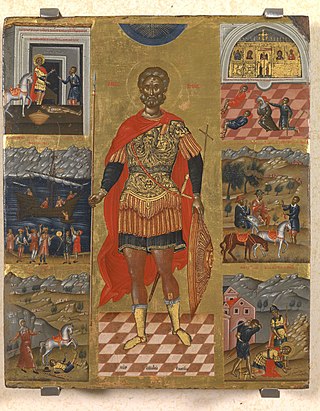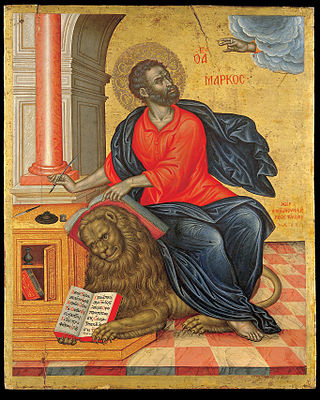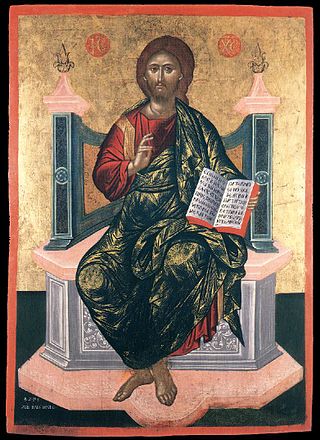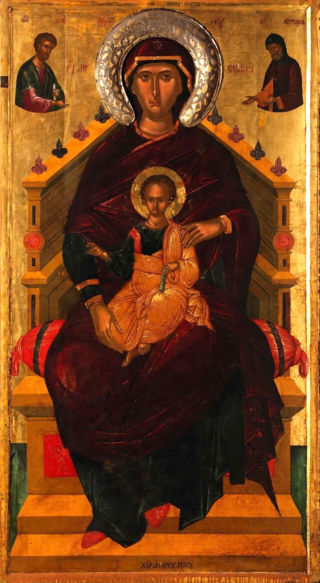
Cretan School describes an important school of icon painting, under the umbrella of post-Byzantine art, which flourished while Crete was under Venetian rule during the late Middle Ages, reaching its climax after the Fall of Constantinople, becoming the central force in Greek painting during the 15th, 16th and 17th centuries. The Cretan artists developed a particular style of painting under the influence of both Eastern and Western artistic traditions and movements; the most famous product of the school, El Greco, was the most successful of the many artists who tried to build a career in Western Europe, and also the one who left the Byzantine style farthest behind him in his later career.

The Heptanese School of painting succeeded the Cretan School as the leading school of Greek post-Byzantine painting after Crete fell to the Ottomans in 1669. Like the Cretan school, it combined Byzantine traditions with an increasing Western European artistic influence and also saw the first significant depiction of secular subjects. The school was based in the Ionian Islands, which were not part of Ottoman Greece, from the middle of the 17th century until the middle of the 19th century. The center of Greek art migrated urgently to the Ionian islands but countless Greek artists were influenced by the school including the ones living throughout the Greek communities in the Ottoman Empire and elsewhere in the world.

Emmanuel Tzanes, also known as BounialisEmmanuel Tzane-Bounialis, Emmanuel Zane, and Emmanuel Tzane. He was a Greek Renaissance painter. He was an author, clergyman, painter, and educator. He was the parish priest of the church of San Giorgio dei Greci. An important Greek church in Venice. He was affiliated with the Flanginian School of the Greek Confraternity in Venice. He was a prominent painter. His known works number over 130 pieces. His works can be found in public foundations, private collections, churches and monasteries in Greece. He collaborated with many artists namely Philotheos Skoufos. Both artists were members of the Cretan School. He was influenced by the Venetian school. Emmanuel's brothers were famous painter Konstantinos Tzanes and poet Marinos Tzanes. His most popular work is The Holy Towel finished in 1659.

Nikolaos Tzafouris, also Niccolo, Niccolò, Niccolö, Zafuri, Zafuris, was a Greek Renaissance painter. He was one of the founders of the Cretan School. He was influenced by Angelos Akotantos. His works influenced Emmanuel Tzanes, Elias Moskos, Georgios Klontzas and Theodoros Poulakis. Tzafouris was one of the most respected artists in Crete. His most notable work is Madre della Consolazione. The painting exhibits a combination of Byzantine and Italian styles. Another notable painter in Crete around the same time was Andreas Pavias. According to the Institute of Neohellenic Research, thirteen paintings are attributed to Tzafouris.

The Icon of the Triumph of Orthodoxy is the festal icon for the first Sunday of Great Lent, a celebration that commemorated the end of Byzantine Iconoclasm and restoration of icons to the church in 843, and which remains a church feast in Orthodoxy. It is the earliest known depiction of this subject, and thought to have been painted in Constantinople, capital of the Byzantine Empire. It was purchased by the British Museum in 1988. The dimensions of the icon are: height: 37.8 cm, width: 31.4 cm, depth: 5.3 cm.

Ioannis Skordilis was a Greek painter. He was active on the Cycladic islands. He shared the same last name as Antonios Skordilis and Emmanuel Skordilis. The family originally came from Crete. They were probably related. Skordilis was a prominent name associated with Cretan painting since the 1500s. Other notable painters of the Cycladic Islands were Christodoulos Kalergis, and Defterevon Sifnios. Twelve of his works survived. They are mainly on the Cycladic islands. His most notable work is at the Byzantine and Christian Museum. It is called the Holy Trinity and Saints. The piece is similar to a work completed by Emmanuel Tzanes; it was a common theme among Greek painters.

Mary Magdalene is a tempera painting by Konstantinos Tzanes. Tzanes was a Greek painter active during the late Cretan Renaissance. Tzanes and his brothers migrated from Crete to Venice. His brother was famous painter Emmanuel Tzanes. They were both active during the 17th century. Twenty-one of his paintings survived. Both brothers uniquely contributed to the maniera greca. They made drastic improvements to the style redefining space and color. Their work is comparable to Michael Damaskinos.

Saint Mark is a tempera-on-wood painting created c. 1657 by Emmanuel Tzanes. Tzanes was a Cretan painter who migrated to Corfu and Venice. He settled in Venice with his brothers Konstantinos Tzanes and poet Marinos Tzanes. Konstantinos was a famous painter. Their combined existing works number over 150. Emmanuel replaced Greek painter Philotheos Skoufos as the priest of San Giorgio De Greco.

Christ Enthroned was a tempera painting created by Elias Moskos. Moskos was a representative of the Late Cretan School. The artist was also associated with the Heptanese School due to his migration to Zakinthos and the transition of his painting style. Moskos also taught painting. Most of his students became church committee members. Church committees were responsible for commissioning paintings. He was active from 1645 to 1687 on the islands of Crete, Zakynthos, and Kefalonia. Fifty-two of his works survived, over half of them were signed. Two other painters named Moskos were active during the same period Ioannis Moskos and Leos Moskos.

Lady the Lambovitissa is a tempera painting by Emmanuel Tzanes. Tzanes was a Greek painter active from 1625 to 1690. His artistic periods can be broken into three parts. The Cretan Period (1625-1647), The Corfu Period (1647-1655), and the Venetian Period (1655-1690). He was a prominent member of the Late Cretan School. His art was heavily influenced by Greek painter Michael Damaskinos. His brothers Marinos Tzanes and Konstantinos Tzanes were both painters. Tzanes has a massive art collection attributed to him nearing over one hundred thirty works. During the Corfu Period (1647-1655), Konstantinos Tzanes and Emmanuel were heavily active. They painted many works on the island.

Christ Enthroned is a tempera icon by Emmanuel Tzanes, a Greek painter of the Late Cretan School. It is currently at the Byzantine & Christian Museum in Athens.

The Virgin Pantanassa is a tempera painting by Andreas Ritzos. Ritzos was a Greek painter active on the island of Crete. He flourished from 1435 to 1492. The painter has an existing catalog of over sixty works attributed to him. He signed his works in both Greek and Latin. He is one of the most influential painters of the Cretan Renaissance. He painted in the traditional Greek-Italian Byzantine style. His work was also heavily influenced by Venetian painting. His teacher was Angelos Akotantos. He was also affiliated with Andreas Pavias. His son was famous Greek painter Nikolaos Ritzos. Ritzo's Italian contemporaries were Paolo Uccello and Fra Angelico. They all painted a mixture of the Greek-Italian Byzantine and Italian Renaissance styles. The art of Crete was heavily influenced by the founder of the Venetian school Paolo Veneziano.

Virgin Glykofilousa is an egg tempera painting by Andreas Karadinos. Karadinos was a Greek painter active from 1680 to 1740. He was a prominent member of the Heptanese School and a representative of the island of Kefalonia. His teacher was famous painter Stephanos Tzangarolas. Karadinos was an Archpresbyter. He was active during the Neo-Hellenikos Diafotismos and Greek Rococo period. One fresco and twenty-two of his paintings have survived. He was also a goldsmith. A unique inscription on a holy table at the church of Agios Spyridon in Kefalonia features important details about his life.

The Virgin Glykofilousa with the Akathist Hymn is a tempera painting created by Greek painter Stephano Tzangarola. The work is a symbol of the craftsmanship of the Heptanese School and the evolution of Greek painting from the Byzantine style to the Cretan Renaissance style. Tzangarola was originally from Crete and migrated to Corfu. The Ionian Islands became the artistic center of the Greek world. He was active from 1675 to 1710 during the Greek Baroque period and Rococo. Twenty-two of his works survived. His student was famous Greek painter and Archpriest Andreas Karantinos.

Constantine and Helen is a painting by Ioannis Moskos. He was a prolific Greek painter associated with Venice and the Ionian Islands. He flourished during the Late Cretan School and early Heptanese School. Three painters with the same last name were active during the same period, the other two were Leos Moskos and Elias Moskos. Ioanni's painting style demonstrates the transition from the Late Cretan School to the early Heptanese School. He began to integrate components prevalent in the Rococo. He was a Baroque artist. According to the Neo-Hellenic Institute, forty-four of his paintings survived.

The Holy Towel is a tempera painting completed in 1659 by Emmanuel Tzanes. He was a representative of the Late Cretan School and the Heptanese School. His brothers were the painter and poet Marinos Tzanes and the painter Konstantinos Tzanes. One hundred thirty works of art are attributed to Emmanuel. He is one of the most important Greek painters of the 17th century along with Theodoros Poulakis. He was from Rethymno Crete. He was active from 1625 to 1690. He was the priest of San Giorgio dei Greci in Venice for thirty years.

The Holy Trinity is a tempera painting created by Spyridon Romas. He was a Greek painter from Corfu. He was a prominent member of the Heptanese School. He was active from 1745 to 1786. He traveled all over the world. He painted in Corfu, Lecce, Livorno, and London. According to the Hellenic Institute over 25 of his works survived. He is one of the few Greek painters to completely adopt a new style of painting. He traveled to London, England around 1770 and remained in the country until his death. He painted several portraits but also maintained artwork in the region. An iconostasis with most of his works is superlatively preserved in Livorno, Italy at the Museo della Città di Livorno.

Saint Onuphrius is a tempera painting created in 1662 by Emmanuel Tzanes. Tzanes is one of the most important Greek painters of the 17th century. He was active in Crete, Corfu, and Venice, Italy. Both of his brothers were painters. He has a massive art catalog attributed to him. According to the Hellenic Institute over one hundred thirty of his works survived. He belongs to the Late Cretan School and Heptanese School of painting. He was part of the movement that introduced Flemish Engravings into the Greek world.

The Incredulity of Saint Thomas is a tempera painting created by Greek painter Emmanuel Tzanes. Tzanes features a catalog of artwork numbering over one hundred works. He was one of the most prolific artists of the 1600s painting in Crete, Corfu, and Venice. His two brothers Marinos Tzanes and Konstantinos Tzanes were also famous painters but Marinos is more well known for his famous poem The Cretan War Ο Κρητικός Πόλεμος. All three artists were members of the Late Cretan School and early Heptanese School (painting) they were known for participating in the movement that integrated Flemish engravings into the Greek and Italian art world.

The Virgin and Child Enthroned is a tempera painting created by Spyridon Romas. He was a Greek painter from the island of Corfu and a prominent member of the Heptanese School active from 1745 to 1786 in Corfu, Lecce, Livorno, and London. Twenty-five of his works survived according to research completed by the Hellenic Institute. One of few Greek painters that changed his style completely Romas transitioned from the Heptanese School to the British style of painting. He traveled to London, England around 1770, and remained in the country until his death. Romas painted several portraits but also maintained art. An important iconostasis containing most of his works is preserved in Livorno, Italy at the Museo della Città di Livorno.
















